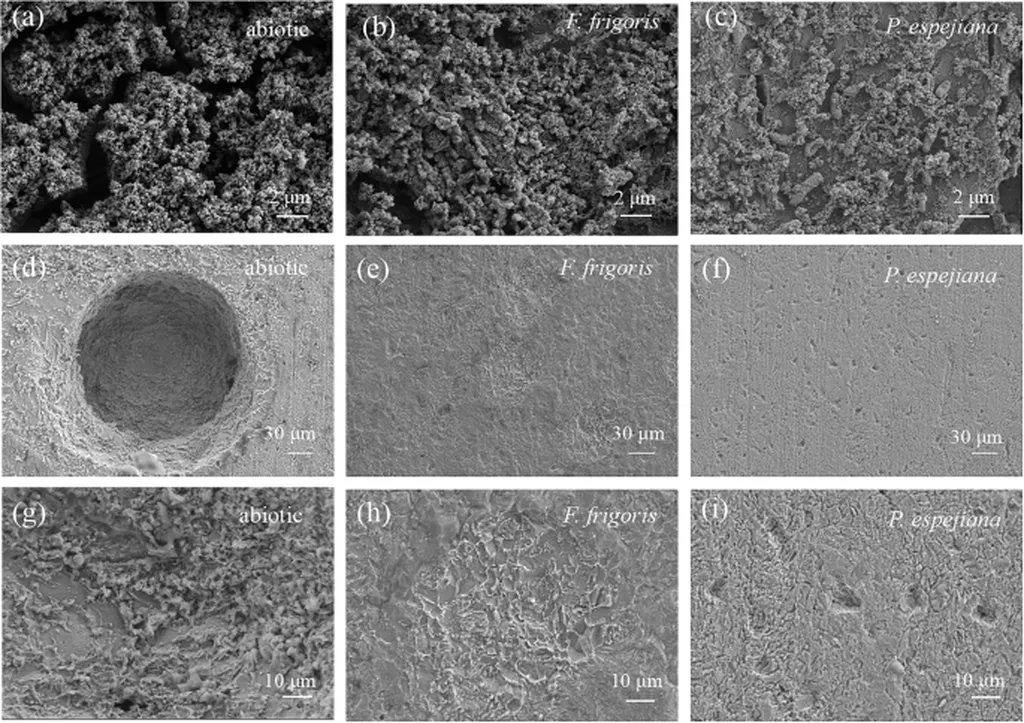In the frosty waters of the Arctic, a silent battle is raging between steel and bacteria, one that could have significant implications for the maritime industry. A recent study, led by Xiaomin Mao from the College of Ocean Science and Engineering at Shanghai Maritime University, has shed new light on this microscopic struggle, revealing how different types of bacterial biofilms can influence the corrosion of steel.
The research, published in the journal ‘npj Materials Degradation’ (which translates to ‘npj Materials Degradation’), focused on two Arctic marine bacterial species: Flavobacterium frigoris and Pseudomonas espejiana. Both were found to induce similar uniform corrosion rates, but their localized corrosion behaviors were distinctly different. This divergence, Mao and her team discovered, was due to variations in the exopolysaccharide (EPS) conformation of the biofilms.
EPS are complex sugar molecules secreted by bacteria, and they play a crucial role in biofilm formation. In the case of F. frigoris, the biofilms were found to have a 24-fold higher content of β-polysaccharides compared to P. espejiana. These β-polysaccharides facilitated the formation of a dense biofilm barrier via hydrophobic fibrous networks and calcium salt precipitation, significantly inhibiting localized corrosion. “The dense structure of the F. frigoris biofilm acts like a protective shield, reducing the impact of corrosive elements on the steel,” Mao explained.
On the other hand, P. espejiana predominantly secreted α-polysaccharides rich in hydrophilic groups. These promoted patchy biofilm colonization, accelerating pitting corrosion. “The patchy nature of the P. espejiana biofilm allows corrosive elements to penetrate more easily, leading to localized damage,” Mao added.
So, what does this mean for the maritime industry? Understanding the role of EPS in biofilm-mediated corrosion could lead to the development of more effective anti-corrosion strategies. For instance, coatings or treatments that mimic the protective properties of β-polysaccharides could be developed to shield steel structures from corrosion. Conversely, treatments that disrupt the formation of α-polysaccharide-rich biofilms could also be beneficial.
The findings also highlight the importance of considering the specific microbial communities present in different marine environments when designing corrosion protection strategies. As Mao noted, “The Arctic marine environment is unique, and the microbial communities here can have a significant impact on the corrosion of steel structures.”
Moreover, with the increasing focus on sustainable and eco-friendly solutions, the development of bio-inspired anti-corrosion strategies could open up new opportunities for the maritime industry. By harnessing the natural properties of certain bacteria, it may be possible to create effective and environmentally friendly corrosion protection methods.
In conclusion, this research underscores the complex interplay between bacteria and steel in marine environments. By unraveling the role of EPS in biofilm-mediated corrosion, Mao and her team have provided a novel theoretical framework for understanding and potentially mitigating this pervasive issue. As the maritime industry continues to grapple with the challenges of corrosion, such insights could prove invaluable in the development of more robust and sustainable solutions.

